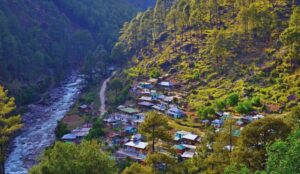Uttarakhand, known as the “Land of the Gods,” is a region steeped in rich history and cultural heritage. Nestled in the lap of the Himalayas, this northern Indian state boasts a tapestry of ancient traditions, legends, and historical milestones that have shaped its unique identity.
Ancient Origins
Uttarakhand’s history dates back to ancient times, with references found in early Hindu scriptures such as the Vedas and the Mahabharata. The region was once part of the larger kingdom of Uttarakuru, mentioned in various Puranas. Archaeological evidence suggests that human settlements in Uttarakhand date back to the prehistoric era, indicating a long-standing human presence in this rugged terrain.
Mythological Significance
The state is renowned for its mythological significance. According to Hindu mythology, the Pandavas from the Mahabharata roamed these lands during their exile, and it is believed that Lord Shiva appeared to them in the form of a bull at Kedarnath. The sacred rivers Ganga and Yamuna originate in Uttarakhand, adding to their spiritual importance.
Medieval Period
During the medieval period, Uttarakhand was divided into the Kumaon and Garhwal regions, each with its distinct cultural and political history. The Katyuri dynasty, which ruled Kumaon from the 7th to the 11th century, left a significant mark on the region with its architectural marvels and administrative reforms. The Chand dynasty succeeded them, contributing to the region’s prosperity and cultural development.
In Garhwal, the Parmar dynasty established their rule around the 9th century. The kingdom flourished under the leadership of rulers like Ajay Pal, who is credited with uniting the fragmented Garhwal region and establishing Srinagar as its capital.
Colonial Era
The advent of the British in the early 19th century brought significant changes to Uttarakhand. After the Anglo-Nepalese War (1814-1816), the British annexed Kumaon and Garhwal, incorporating them into the United Provinces of Agra and Oudh. The colonial period saw the development of infrastructure, including roads, railways, and hill stations like Nainital and Mussoorie, which became popular summer retreats for the British.
Post-Independence and Statehood
Post-independence, Uttarakhand continued to be part of Uttar Pradesh. However, the unique cultural and geographical identity of the region fueled demands for a separate state. After years of persistent efforts and struggles, Uttarakhand was officially carved out of Uttar Pradesh on November 9, 2000, becoming the 27th state of India.
Modern Uttarakhand
Today, Uttarakhand is known for its scenic beauty, adventure tourism, and pilgrimage sites. Cities like Dehradun, Haridwar, Rishikesh, and Nainital attract tourists from all over the world. The state’s economy thrives on tourism, agriculture, and hydropower, contributing to its steady growth and development.
Conclusion
Uttarakhand’s history is a testament to its resilience and cultural richness. From ancient civilizations to modern development, the state has preserved its heritage while embracing change. As Uttarakhand continues to evolve, it remains a land of timeless beauty and spiritual significance, inviting all to explore its historical treasures and natural wonders.
FAQs About Uttarakhand’s history
1. What is the origin of the name ‘Uttarakhand’?
The name ‘Uttarakhand’ is derived from the Sanskrit words ‘Uttara’ meaning ‘North’ and ‘Khand’ meaning ‘Land’. It signifies the northern region of India.
2. When was Uttarakhand established as a separate state?
Uttarakhand was established as a separate state on November 9, 2000. It was carved out of the northern part of Uttar Pradesh.
3. What are the historical significances of Uttarakhand?
Uttarakhand holds great historical significance due to its ancient temples, spiritual heritage, and as a significant region in Hindu mythology. It is home to the Char Dham pilgrimage sites – Yamunotri, Gangotri, Kedarnath, and Badrinath.
4. Who were the early inhabitants of Uttarakhand?
The early inhabitants of Uttarakhand included various indigenous tribes like the Jaunsari, Bhotia, Tharu, and Raji. They have a rich cultural heritage and unique traditions.
5. What are some important historical sites in Uttarakhand?
Important historical sites in Uttarakhand include the Kedarnath and Badrinath temples, the Jageshwar temple complex, and the ancient town of Haridwar, which is one of the seven holiest places in Hinduism.









